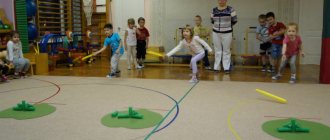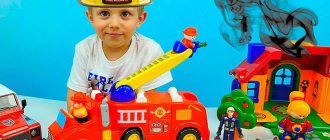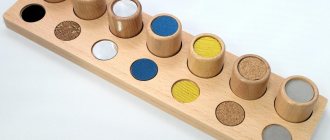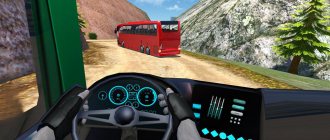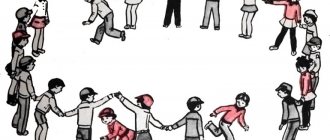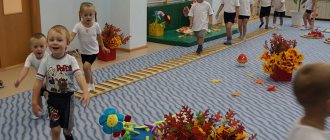While playing, a child gets to know the world, learns its laws and principles. You can compete by running and jumping and acquire various skills according to a certain algorithm - rules. Outdoor games for children will help you prepare for life and learn dexterity and ingenuity. The knowledge and skills that a child acquires during play activities help to develop correctly.
Classification of outdoor games
There are different types of outdoor games. Their classification was introduced for ease of use in practice.
Classification table:
| On what basis are they classified? | View |
| Difficulty level | sports |
| elementary mobile | |
| Activity level | low mobility |
| medium mobility | |
| great mobility | |
| Figurative content | plotless |
| plot | |
| Nature of action | competitive |
| collective |
For the little ones
For children 1-3 years old, classes in the gym are good. Nursery groups do not use games with competitive elements. All classes in preparatory groups should be health-saving.
Children aged 1-4 years are not yet coordinated, so some fun activities can be dangerous. You need to worry about preventing injuries. The very definition of games for little ones can be briefly formulated: safe, interesting, simple tasks.
For such games, the minimum group is 2-3 children. Meanwhile, music will help you have fun indoors.
The hare treats the bear
Necessary equipment for this game: 2 chairs, a bucket of water, an empty bucket, a mini plastic cup, a bear toy.
Methodology:
- Place the buckets on different chairs at a distance of 2 m from each other. Place a toy near one of the buckets.
- A full bucket is a treat from the hare for the bear
- The bucket next to which the toy is located should be filled halfway with water using a glass in which children carry water.
- The teacher (parent) reads the poem:
The brown bear is one year old,
Let's treat you to compote,
Two cute bunnies
Together with the hippopotamus.
Burner
Required equipment: chair, bucket and spoon.
Methodology:
- Place the bucket on the chair and give the child a spoon.
- The teacher (parent) reads the poem:
We cook national soup,
Cabbage soup is boiling with cabbage,
Bright, cool, useful,
And it’s delicious too!
- The child makes rotational movements with a spoon in a bucket.
The teacher reads:
Spun, spun,
And they stopped interfering!
- The child spins around himself 2 times and gives the spoon to another.
- The game continues until all children have stirred the cabbage soup.
Automobile
Required equipment: 3 chairs.
Methodology:
- Place chairs next to each other.
- The teacher (parent) reads:
I'll go to the river alone,
I'll sit down quickly.
- One of the children sits on a chair, the rest of the children continue to walk. The teacher (parent) reads:
The two of us will go to the river,
Let's invite friends.
- The second child sits on a chair, the remaining child continues to walk. The teacher (parent) reads:
The three of us will go to the river,
It will be more fun!
- The last child sits on the remaining chair. The game is over when all three children are sitting on their chairs.
The schemes are very different, but it is important to take into account age (it may be indicated in the title of the video). The selection of music used during games should be dominated by light classics and children's songs.
Card index of outdoor games for children of different age groups
Irina Vlasyuk
Card index of outdoor games for children of different age groups
Junior group
Outdoor game “Run to me.”
Goal: to train children to act on a signal, to run in a forward direction simultaneously as a whole group.
How to play: Children stand on one side of the hall, so as not to interfere with each other. The teacher stands on the opposite side. He says: “Run to me, everyone, everyone, run to me!” The children run to the teacher, who greets them warmly, spreading his arms wide to the sides, and pretends that he wants to hug all the children. After the children gather around the teacher, he goes to the other side of the playground and again says: “Run to me!” Before the start of the game, the teacher reminds that you can run only after the words “Run to me!”, You cannot push and interfere with each other.
Those who want to play can be divided into two small groups: while one group plays, the other watches, then they change roles.
Middle group
Outdoor game "Hares and wolves"
Tasks:
To develop in children the ability to perform movements on a signal, to practice running, jumping on both legs, squatting, and catching.
Description: One of the players is assigned to be a wolf, the rest portray hares. On one side of the site, the hares mark their places with cones and pebbles, from which they lay out circles or squares. At the beginning of the game, the hares stand in their places. The wolf is at the opposite end of the site - in the ravine. The teacher says: “The bunnies jump, hop - hop - hop, onto the green meadow. They nibble the grass and listen to see if a wolf is coming.” The hares jump out of the circles and scatter around the site. They jump on two legs, sit down, nibble the grass and look around in search of the wolf. The teacher says the word “Wolf”, the wolf comes out of the ravine and runs after the hares, trying to catch and touch them. The hares each run away to their own place, where the wolf can no longer overtake them. The wolf takes the caught hares to his ravine. After the wolf catches 2-3 hares, another wolf is chosen.
Rules:
Hares run out at the words - hares gallop.
You can return to your place only after the word “Wolf!”
Options: You cannot catch those hares to whom the mother hare gave her paw. Place stump cubes on the way, the hares run around them. Choose 2 wolves. The wolf has to jump over the obstacle - a stream.
Senior group
Outdoor game "Find the ball"
Goal: To develop children's observation and dexterity.
Description: All players stand in a circle close together, facing the center. One player becomes the center, this is the speaker. The players keep their hands behind their backs. One is given a ball in his hands. Children begin to pass the ball to each other behind their backs. The driver tries to guess who has the ball. He can ask each of the players to show their hands by saying “hands.” The player extends both hands forward, palms up. The one who has the ball or who dropped it stands in the middle, and the driver takes his place.
Rules: The ball is passed in any direction. The ball is passed only to the neighbor. You cannot pass the ball to a neighbor after the driver demands to show his hands.
Options:
Put two balls into play. Increase the number of drivers. Give the person who has the ball a task: jump, dance, etc.
Senior preschool age (5-7 years)
The school gym or courtyard is a great place to practice. So that the child does not constantly strive to play GTA and other online games on the computer, but finds excitement in movement, it is important for him to be properly offered alternative entertainment.
A card index of outdoor games will become an assistant in education and children's physical development. For older preschoolers, you can use the same stories as for others.
Sports competitions are also fun and interesting for children. Such children's outdoor games develop the following qualities:
- desire for an active lifestyle,
- endurance,
- developed strength,
- resourcefulness,
- collective spirit,
- reaction.
Goose, wolf and boy
What is developed and used: speed, agility.
Features: 7-10 children are needed to play, crayons are needed.
- Choose “wolf” and “boy”, the rest of the children are “geese”.
- Draw a circle on the site, the “geese” will hide in it.
- At a distance of 4-6 m (four meters is a minimum) draw another circle - the “wolf’s” house.
- The “geese” are initially in the “wolf’s” house, and the “wolf” is in the “geese” house.
- The “boy” kicks the “geese” out for a walk. They scatter across the site, running towards their house. The wolf reads a poem:
Day or night doesn't matter to me
I'm good at speed
I'm in the meadow
Here I will find all the geese.
I look scary though,
But I catch geese for a reason.
- The task of the “wolf” is to touch the “geese” and catch them all. The caught "geese" stands in the circle of the "wolf". The goal of the “geese” is to get into their home.
- Once all the “geese” are caught, the children change roles.
Children's volleyball
The famous but adapted version of volleyball is suitable for both kindergarten and any other group of children. An interesting and sporty game is played using a light playing ball.
Children have the opportunity to demonstrate individual skills because everyone plays for themselves. Healthy pastime will teach every child to healthy lifestyle. And summer is the best time for volleyball.
What else to read: Game Twister - dancing on colorful circles
Basis:
- 5-9 children stand in a circle.
- The child’s task is to hit the ball towards another player, or catch it.
- One game is given 6-8 minutes.
- Each participant needs to score as many points as possible:
- 1 point – for a caught ball,
- 2 points – for a hit ball,
- 5 points – if the ball was hit towards another participant at chest level.
- The one who scores the most points wins.
Owl
Includes both creative focus and motor activity. This team game is unusual and multi-component.
What is developed and involved: coordination, imagination.
Features: 8-9 children are needed to play, chalk is needed.
- A girl is selected from a group of children to be an “owl”.
- Since this is a team game, the remaining children are divided into two teams of “mice”.
- A round “mousetrap” with a diameter of 1 m is drawn on the asphalt.
- "Mice" are running around the "mousetrap". "Owl" says:
I'm an owl, Valentina,
I don't like raspberries,
I love catching mice
Wow, wow, tell everyone,
The sun is shining for everyone,
I will not eat…
- “Owl” names a word - any animal that an owl cannot eat. The “mice” must stop and imitate this animal.
- Whoever completes the task slowest goes into the mousetrap.
- The last mouse remaining outside the circle wins.
Outdoor games for children 3–7 years old with a detailed description of the rules of the game
Maria Balashova (Maleeva)
Outdoor games for children 3–7 years old with a detailed description of the rules of the game
Outdoor games for children 3-7 years old with a detailed description of the rules of the game.
The role of play in the formation and development of a child cannot be overestimated. It is in play that a child learns about the world around him, its laws, and learns to live according to the rules . All children love to move, jump, gallop, and run races. Outdoor games with rules are a conscious , active activity of the child, which is characterized by timely and accurate completion of tasks related to the rules that are mandatory for all participants. Outdoor play is a kind of exercise with which children prepare for life.
• Classification of outdoor games . Outdoor game in the pedagogical process
• Russian folk outdoor games in kindergarten . Implementation of the regional component of the program in preschool educational institutions
• Outdoor games for first grade children (6-7 years old)
Outdoor games are of great importance in a child’s life, as they are an indispensable means for a child to gain knowledge and ideas about the world around him. They also influence the development of thinking, ingenuity, dexterity, dexterity, and moral-volitional qualities. Outdoor games for children strengthen physical health, teach life situations, and help the child receive proper development .
Children of primary preschool age in play, as a rule , imitate everything they see. In children's outdoor games , as a rule , it is not communication with peers that is manifested, but a reflection of the life that adults or animals live. Children at this age enjoy flying like sparrows, jumping like bunnies, flapping their arms like butterflies with wings. Thanks to the developed ability to imitate, most outdoor games of children of primary preschool age have a plot character.
The content of outdoor games for young children 3-4 , 4-5 years old in kindergarten is aimed at developing types of movement: running, jumping, climbing.
• Outdoor game “Mice dance in a circle”
Goal: develop motor activity
Description : before starting the game you need to choose a driver - “cat”
.
The cat chooses a “stove”
(it can be a bench or a chair), sits on it and closes his eyes. All other participants join hands and begin to dance around the cat with the words:
The mice dance in circles
The cat is dozing on the stove.
Quieter than a mouse, don't make noise,
Don't wake up Vaska the cat,
Vaska the cat will wake up -
He’ll break up our round dance!”
While pronouncing the last words, the cat stretches, opens his eyes and begins to chase mice. The caught participant becomes a cat, and the game starts over.
• Game “Sunshine and Rain”
Objectives: to teach children to find their place in the game, navigate in space, develop the ability to perform actions on a signal from the teacher.
Description : Children sit in the hall on chairs. Chairs are their “home”
.After the teacher’s words:
“What good weather, go for a walk!”
, the guys get up and begin to move in any
direction . As soon as the teacher says: “It’s raining, run home!”
, children must run to the chairs and take their place.
The teacher says “Drip – drip – drip!”
Gradually the rain subsides and the teacher says:
“Go for a walk.
The rain has stopped!” .
• Game “Sparrows and the cat”
Objectives: teach children to jump gently , bending their knees, run, dodge the driver, run away, find their place.
Description : Circles are drawn on the ground - “nests”
.
Children - “sparrows”
sit in their
“nests”
on one side of the playground.
On the other side of the site there is a “cat”
.
As soon as the “cat”
falls asleep,
the “sparrows”
fly out onto the road, fly from place to place, looking for crumbs and grains.
The “cat”
wakes up, meows, and runs after the sparrows, which must fly to their nests.
First the role of the “cat”
performed by the teacher, then by one of
the children .
• Outdoor game “Sparrows and a car”
Another game for children 3-5 years old about sparrows.
Objectives: to teach children to run in different directions , to start moving or change it at the leader’s signal, to find their place.
Description : Children are “sparrows”
, sitting in their
“nests” (on the bench)
.
The teacher depicts a “car.”
As soon as the teacher says:
“The sparrows have flown onto the path
,” the children rise from the bench and begin to run around the playground. At the teacher’s signal:
“The car is moving, fly the sparrows to their nests!”
-
the “car”
leaves
the “garage”
, and the children must return to the
“nest” (sit on the bench)
.
The "car"
returns to the
"garage"
.
• Game "Cat and Mice"
There are many games for children with cats and mice involved. Here is one of them.
Objectives: This active children develop the ability to perform movements on a signal. Practice running in different directions .
Description : Children are “mice”
sitting in holes
(on chairs along the wall)
.
In one of the corners of the playground sits a “cat”
- a teacher. The cat falls asleep and the mice scatter around the room. The cat wakes up, meows, and begins to catch mice, which run into their holes and take their places. When all the mice return to their holes, the cat walks through the hall again, then returns to its place and falls asleep.
• Outdoor game for preschoolers “At the Bear in the Forest”
Objectives: develop the speed of reaction to a verbal signal, exercise children in running , develop attention.
Description : Among the participants, one driver is chosen to be the “bear”
.
Draw two circles on the playground. The first circle is the bear's den, the second circle is the home for the rest of the game .
The game begins with the children leaving the house with the words: There is a bear in the forest
I take mushrooms and berries.
But the bear doesn't sleep,
And he growls at us.
As soon as the children said these words, "bear"
runs out of the den and catches
the children . The one who did not have time to reach the house and was caught by the “bear”
becomes the driver (
“bear”
).
• Through the stream ( an active game with jumping )
Objectives: Teach how to jump correctly , walk along a narrow path, and maintain balance.
Description : Two lines are drawn on the site at a distance of 1.5 - 2 meters from one another. At this distance, pebbles are drawn at a certain distance from each other.
The players stand at the line - on the bank of a stream, they must cross (jump over)
over the pebbles without getting your feet wet. Those who stumbled and got their feet wet go to dry them in the sun and sit on a bench. Then they get back into the game.
• Game “Birds and Cat”
Objectives: Learn to follow the rules of the game . React to a signal.
Description : for the game you will need a mask of a cat and birds, and a large circle drawn.
Children stand in a circle on the outside. One child stands in the center of the circle (the cat falls asleep (closes his eyes, and the birds jump into the circle and fly there, pecking at the grains. The cat wakes up and begins to catch the birds, and they run away outside the circle.
• Game “Snowflakes and the Wind”
Tasks: Practice running in different directions , without bumping into each other, act on a signal.
Description : At the signal “Wind!”
children -
“snowflakes”
- run around the playground in different
directions , spinning ( “the wind swirls snowflakes in the air”
).
At the signal “No wind!”
- squat (
“snowflakes fell to the ground”
).
• Outdoor game “Find yourself a partner”
Objectives: to develop in children the ability to perform actions on a signal, to quickly form pairs.
Description : Participants stand along the wall. Each of them receives a flag. As soon as the teacher gives a sign, the children scatter around the playground. After the command “Find yourself a mate”
, participants with flags of the same color are paired up.
An odd number of children must participate in the game and at the end of the game one is left without a pair.
All of these outdoor games can be successfully used for playing in a kindergarten in a group or on a walk. Children of different ages: from 3-year-old children to children of the middle group enjoy playing them.
• Outdoor games for children 5-7 years old
In children 5-6 , 6-7 years old, the nature of play activity changes somewhat. Now they are already beginning to be interested in the result of the outdoor game , they strive to express their feelings, desires, and implement their plans. However, imitativeness and imitation do not disappear and continue to play an important role in the life of an older preschooler. These games can also be played in kindergarten.
• Game "Bear and Bees"
Tasks: practice running, follow the rules of the game .
Description : participants are divided into two teams - “bears”
and
"bees"
.
Before the start of the game, the “bees”
take places in their
“hives” (benches or ladders can serve as hives)
.
At the command of the leader, the “bees”
fly to the meadow for honey, and at this time
the “bears”
climb into
the “hives”
and feast on honey.
Hearing the signal “Bears!”
, all
the “bees”
return to
the “hives”
and
“sting” (salat)
the “bears”
who did not have time to escape .
The next time, the stung “bear”
no longer goes out to get honey, but remains in the den.
• Game "Burners"
Tasks: practice running, respond to a signal, follow the rules of the game .
Description children take part in the game , who become pairs and hold hands. In front of the column there is a driver who looks forward. The children repeat the words in chorus:
Burn, burn clearly
So that it doesn't go out,
Look at the sky -
Birds are flying
The bells are ringing!
Once! Two! Three! Run!
As soon as the participants say the word “Run!”
those standing in the last pair in the column release their hands and run forward along the column, one on the
right side , the other on the left.
Their task is to run forward, stand in front of the driver and join hands again. The driver, in turn, must catch one of this pair before they hold hands. If you manage to catch, then the driver and the caught one will form a new pair, and the participant left without a pair will now lead. • Outdoor game “Two Frosts”
A well-known game for preschoolers with simple rules . Objectives: to develop inhibition in children , the ability to act on a signal, and practice running.
Description : On opposite sides of the site there are two houses, indicated by lines. Players are placed on one side of the court. The teacher selects two people who will become drivers. They are located in the middle of the area between the houses, facing the children. These are two Frosts - Red Nose Frost and Blue Nose Frost. At the teacher’s signal “Start!”
both Frosts say the words: “We are two young brothers, two frosts are daring.
I am Frost Red Nose. I am Frost Blue Nose. Which of you will decide to set out on the path?” All the players answer: “We are not afraid of threats and we are not afraid of frost”
and run to the house on the opposite side of the site, and Frosts try to freeze them, that is, touch them with their hands. Those of the guys who were touched by Frost freeze in place and remain like that until the end of the run. The frozen ones are counted, after which they join the players.
• Game "Sly Fox"
Goal: to develop agility, speed, coordination.
Description : A line is drawn on one side of the site, thereby indicating the “Fox House”
.
The teacher asks the children , who are located in a circle, to close their eyes. the formed circle behind and touches one of the participants, who from that moment becomes a “sly fox
.
After this, the teacher invites the children to open their eyes and, looking around, try to determine who the sly fox is. Then the children ask 3 times: “Sly fox, where are you?”
.
At the same time, the questioners look at each other. After the children have asked the third time, the sly fox jumps into the middle of the circle, raises his hands up and shouts: “I’m here!”
.
All participants scatter around the site in all directions, and the sly fox tries to catch someone. After 2-3 people are caught, the teacher says: “In a circle!”
and the game starts again.
• Game “Deer Catching”
Objectives: practice running in different directions , agility.
Description : Two shepherds are selected from among the participants. The remaining players are deer located inside the outlined circle. The shepherds are behind the circle, opposite each other. At the leader’s signal, the shepherds take turns throwing the ball at the deer, who try to dodge the ball. The deer that the ball hit is considered caught and leaves the circle. After several repetitions, he counts the number of deer caught.
• Game "Fishing Rod"
Objectives: develop dexterity, attention, speed of reaction.
Description : participants are located in a circle. In the center there is a driver - a teacher. He holds a string in his hands, at the end of which a small bag of sand is tied. The driver rotates the rope in a circle just above the ground. Children jump in such a way that the rope does not touch their legs. Those participants whose legs are hit by the rope are eliminated from the game .
• Game “Hunters and Falcons”
Tasks: practice running.
Description : All participants - falcons - are on one side of the hall. There are two hunters in the middle of the hall. As soon as the teacher gives the signal: “Falcons, fly!”
participants must run to the opposite side of the hall.
The hunters' task is to catch (spot)
as many falcons as possible before they have time to cross the conditional line. Repeat the game 2-3 times, then change the drivers.
• Game "Spider and Flies"
Objectives: to develop in children the ability to perform actions on a signal.
Description : in one of the corners of the hall, a circle indicates a web in which there is a spider - the driver. All the other guys are flies. All flies "fly"
around the hall, buzzing.
At the presenter’s signal “Spider!”
the flies freeze. The spider comes out of hiding and carefully examines all the flies. He takes those who move into his web. After two or three repetitions, the number of flies caught is counted.
• Outdoor game “Mousetrap”
Objectives: to develop in children the ability to perform actions on a signal.
Description : Two participants stand facing each other, join their hands and raise them higher. After this, both say in unison:
“How tired we are of the mice, they gnawed everything, ate everything!
We’ll set up a mousetrap and then we’ll catch the mice!”
While the participants are saying these words, the rest of the guys must run under their clasped hands. At the last words, the presenters abruptly lower their hands and catch one of the participants. The caught one joins the catchers and now there are three of them. So the mousetrap gradually grows. The last participant remaining is the winner.
Games for schoolchildren
Outdoor games are an opportunity to provide children with comprehensive development. Modern collections for teachers contain an interesting catalog of funny games in the form of exercises, sports and games that develop the imagination.
The importance of physical activity for schoolchildren is colossal.
This is an acquaintance with new concepts, acquiring the skills necessary in life. Of course, when introducing new games by teachers, approval will be required. List of the most important equipment that will come in handy:
- volleyball ball,
- soccer ball,
- plastic skittles,
- gates,
- basketball basket,
- checkbox.
A set of exercises that children perform during the game develops the vestibular apparatus, dexterity, speed and strength. The content and rules are not complicated, but they train your ingenuity.
The number of participants has practically no effect on the game process, but it is desirable that there be at least 10-11 children. Main classification of games:
- plot,
- sports,
- combined.
It is extremely important to choose a game for children that is appropriate for their age and season. After all, for an older child both the workload and tasks will be more difficult.
Didactic materials facilitate the educational process. These can be in the form of brochures, books and videos. All means that help parents and teachers interest modern children are good.
Junior schoolchildren
At 6-7 years old, children are accustomed to story-based games, but they need to start introducing sports elements.
Alphabet and dictionary
Purpose of the game: improving literacy, learning the native language.
Inventory: clothespins with letters, cards with words of equal difficulty.
- Children are divided into teams and choose captains.
- The captains randomly select task words for the opposing team.
- Find the letters that make up the words for the opposing team.
- The captains attach letters to the backs of the opposing team members.
- The teams line up.
- On the count of 1-2-3, the captains show the words that need to be collected.
- The team that completes the word faster by lining up in a row wins.
Hide and seek
Orientation: hide well, then run to the base.
Features of the location: a courtyard with enough safe places to hide.
- Children choose a courseworker who will search.
- The student, while at the base, closes his eyes and counts to 20.
- At this time, the participants in the game hide.
- If the courseworker finds a participant, he runs to the base and calls the name of the found participant.
- The goal of the participants: to reach the base and say their name before the coursework.
Other games
At the age of 7-8, children can already play mini-football and hockey (they will need ice at a skating rink), which will allow them to develop running speed and the ability to work in a team. At the age of 7-9, children begin to play classic volleyball.
Outdoor games based on fairy tales
Outdoor games based on fairy tales
Relevance of the topic:
Physical activity is a biological need of the body, the satisfaction of which determines the health of children, their physical and general development.
Target:
create the need for active physical activity, increase a positive attitude.
Tasks:
- expansion of motor experience and enrichment of it with new, more complex movements;
— development of creative abilities and physical qualities;
— fostering independence and activity;
— improvement of motor skills
"Kolobok"
Children form a circle. Using a counting table, they choose the leader - “Kolobok”. “Kolobok” runs in a circle and sings:
I am Kolobok, Kolobok, in a box of marks, baked on eggs - I ran away from a woman and a grandfather, I ran away from a hare and a wolf, I ran away from a bear and a fox! And I'll run away from you!
At the same time, he touches the hand of the child whose words he has finished pronouncing, and runs away from her. The child catches it, and “Kolobok” runs in a circle and tries to take the child’s place. Complications: both need to overcome an obstacle course: jump from circle to circle, walk along a bench, crawl under an arc.
"Spikelet"
The “cockerel” is chosen using the counting machine. He is holding a spikelet. The rest of the children are “mice”. The “mice” are “sleeping”, and the “cockerel” says:
Hey lazy mice! Enough rest already. All you know is what to play
You start working. Find the spikelet. Whoever finds it, thresh it and bake some pies!
The “cockerel” itself hides the spikelet at this time. After the last words, the little mice “wake up” and go to look for the spikelet. Whoever finds it first becomes the “cockerel”.
"Straw Bull"
Among the children, 2-3 “straw bulls” are chosen. The rest of the children are “animals” who live in the forest in their “houses” (hoops). At the signal, the “straw bulls” must, within 30 seconds, “attach” more “animals” to their “tail” (ropes) and lead them to their “house”. The one who catches the most “forest inhabitants” wins.
"The hare is a braggart"
Use a counting machine to choose a “hare”. Children form a circle. “Hare” stands in the middle of the circle and says:
I am the Jumping Hare! I don’t have a mustache, I have whiskers, Not teeth, but teeth, Not paws, but paws. I'm not afraid of anyone! And the children say: Listen, Hare, don’t boast, you run, run, run!!!
The “hare” runs away, and the children catch up with him. Whoever catches the “hare” first becomes the leader. The game repeats itself again. Complication: children walk on one leg.
"Kotigoroshko"
Children unite into two teams: Snake and Kotigoroshko. Two children come out - one from each team. Children sit opposite each other, resting their feet on the opponent’s feet, holding one stick in front of them. At the signal, they try to raise the opponent to his feet. Whoever succeeds is the winner. After this, a new couple comes out.
"Koza-Dereza"
Children form a circle and draw “huts” around themselves. One child is chosen as “Goat - Tree”. She approaches any “hut”, jumps there and says: I am the Goat-Dereza, Black eyes, crooked leg, sharp horns!! Tap-tap with my feet, I'll stab you with my horns. I'll trample with my feet, I'll sweep with my tail, Run out of the house!
The children answer: “You, Goat, don’t tease us, but try to overtake us!”
After these words, both on one leg try to jump around the “hut” as quickly as possible. One jumps on the right, the second on the left. Whoever returns first remains there as the owner, and whoever is late becomes the “Goat-Dereza”.
Game – competition “Turnip”
The teacher unites the children into two teams. Children pick up a rope. At the teacher’s signal, they begin to pull him in different directions. Whoever pulls out the “turnip” is the winner. The game can be played with a gradual addition of players. You can play until the last winner (the team that wins is combined into two teams, and the competition continues until one player wins).
Relay game “Rukavichka”
Children are united in two teams: “blue” and “green” gloves. They line up in a column, one at a time, on one side of the court, and on the opposite side they place baskets with flags according to the number of children in one team. The first children in both teams are “mice”, then “frogs”, “bunnies”, “foxes”, “wolves”, “bears”. At the teacher’s signal, the children standing first run to the opposite side, take the flag and return to their team, passing the baton. The team that brings the flag to its “glove” the fastest wins. Complication: steeplechase.
"Gold fish"
The teacher chooses “Grandfather the fisherman” with a counting rhyme, and the rest of the children choose “fish”. The teacher says: “And grandfather threw a net...” After these words, the “fish” “swim.” As soon as the “grandfather” begins to “catch fish,” the children run away. Which “fish” the “grandfather” will catch and fulfill his three wishes (dances, sings, performs certain movements). Complications: “catching a fish” with a large hoop; The “fisherman” knocks out the “fish” with the ball; a “fisherman” can “catch a fish” blindfolded; The “fish” run away in pairs.
Middle and high school students
Older students will be interested in different games than primary school students. From a pedagogical point of view, it is more difficult to captivate a teenager than younger children.
This task will be easier to cope with if new games are introduced that keep up with the times. Games in nature are especially useful for schoolchildren, because ordinary walks will not provide the necessary physical activity.
Lincoln's snowball blunder
High school students will also want to play an exciting game with a popular plot. Winter fun will captivate every child.
Features: carried out in winter, when there is enough fresh snow and not severe frost, there is sufficient space outside.
Details: a plastic bottle with colored rice (rice is painted with food coloring) will imitate a bottle of holy water; a picture depicting a city map, red and blue ribbons for each participant.
What else to read: Children's fun game “Two Frosts”
Story for the plot: President Lincoln fights werewolves. The werewolves are sitting in the fortress, the president and his assistants are in the apartment. They decide to go fight evil. The object of the struggle is a map of the city, which the werewolves keep in their fortress.
Organization of the game:
- The day before you need to make 2 fortresses at a distance of 9-10 m from each other, the height of a child.
- Teams of werewolves, Lincoln and his assistants are selected.
- Each participant marks himself with a ribbon: the werewolves are red, the wrestling team is blue.
- The werewolves take a position in their fortress, and the map is located in this fortress. Werewolf weapons: snowballs.
- The President and his team occupy the second fortress-apartment. Their weapons: a bottle of holy water (dyed rice) and snowballs.
- Lincoln jumps up so that the werewolves can see it and waves his hand, saying: “I won’t give you an easy life, but I’ll show you an example. The only way for you to save yourself is to give the card to us!”
- After this, the werewolf hunters try to run to their opponents' fortress and take the map. Werewolves are trying to break into the president's apartment.
- If a snowball hits a member of one of the teams, he is eliminated from the game for three minutes. When holy water hits a werewolf, he is knocked out for 10 minutes.
- The game ends when the president's team has captured the map, or if a third of the werewolves have entered the apartment.
Relay race
Relay races are known in every school; they are held in physical education classes. Conducting relay races improves physical fitness and strengthens the competitive spirit. General principle:
- Invite children to divide into teams.
- Form teams into columns at the starting line.
- On the command “March!” the captain runs (jumps) to the flag, touches it with his hand and returns to the team.
- Pats the next person in the column on the shoulder, who performs the same actions as the captain, and so on.
- The winner is the team whose last link returns to the starting line first.
Other games
High school students do athletics and run short distances. But still, they will play football with great pleasure. The purpose of outdoor play is not only to improve physical characteristics, but also to instill a lifelong love of sports.
